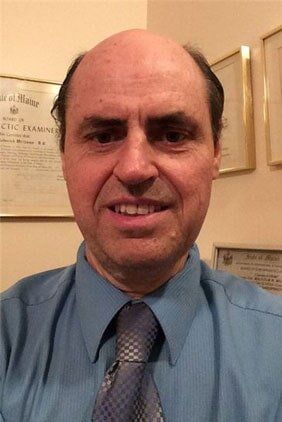CHIROPRACTORS IN PORTLAND, ME

About Our Doctor
Dr. Malcolm Williams graduated Summa Cum Laude from Palmer College of Chiropractic, Davenport, Iowa, in 1977. He was the Head Intern for the Sacro-Occipital Technic Department in the Palmer Public Clinic and was a teaching assistant in the Advanced Sacro-Occipital Technic.
After graduating, he practiced in Dallas, Texas for 5 years before moving to Maine, opening the office at 558 Main Street, South Portland in May of 1982.
He is a member of the Maine Chiropractic Association and of the American Chiropractic Association.
His Work
Some cases are simple and straight forward, especially when the person gets care at the earliest sign of there being a problem. Too often when things feel a little better, people tend to wait thinking it will get better on its own, but the body just compensates for the problem and sets things up for a bigger or recurring problem later. When someone comes with a health issue, often there are many incidents and stresses and strains that lie behind the presenting crisis.
Dr. Williams gathers as much information as the patient can provide to understand how the person got to where they are and to encompass the full scope of the current condition. He then does an examination including observation and measurement of movements, palpation of the spine and other bones both stationary and with movement, evaluation of the muscle tone and other soft-tissue in the involved areas as well as taking vital signs. Not routinely, but if indicated, Dr. Williams will send a patient out for x-rays, other imaging studies or lab tests.
Working with each person, Dr. Williams draws from his years of experience to focus on what needs to be done to correct the problem. His understanding of the inter-relationship of the parts of the whole help him to see the connections that need to be addressed to resolve some very persistent and long-term issues. He works as gently as possible in the adjusting processes to realign the involved joints. Then he will determine what if anything is needed to support that correction in terms of therapies like myofascial release, electrical stimulation, ultrasound, ice pack or using supports.
Not only does he assess and correct areas of the spine, but Dr. Williams has a lot of training and experience in working with all of the other joints in the body. He frequently works with old and new injuries to the feet, ankles, knees, hips, shoulders, elbows and wrists. The ribs sometimes need attention too and a fairly common joint needing work is the jaw or TMJ. Less frequently some cranial bone work is needed when the bones of the skull have ended up not aligned properly.
In everyday life we all face so many stresses and strains on top of the injuries we encounter from lifting, twisting, falling and other activities, including the more and more frequent ones now of sitting too long especially at the computer. Small injuries are often cumulative, and it is only when the pain doesn't go away that they get our attention. Once things are corrected, we need to be more mindful of how not to recreate them. Dr. Williams works to educate each patient about how to sustain good posture, how to change the things we do habitually and how to address other aspects of improving our health and well-being.
Dr. Williams' assessment will at times include looking at the feet with a digital foot scan. He stresses the importance of the good functioning foot structure with all three foot arches properly maintained. When one of these arches collapses, trouble will follow, maybe not today but certainly at some point not too far down the road. This is the system that keeps us balanced when we are standing and even more so when we add movement into the picture. Foot problems, cause ankle problems, cause knee problems, cause hip problems and then ultimately disturb the equilibrium of the whole body. In these situations, Dr. Williams will recommend a custom pair of Foot Leveler orthotics to help correct the foot problems.
Chiropractic
The body can do some correcting on its own if the imbalance is new and is simple. It does this when we do good exercise in a balanced way and when we sleep, if we sleep in a properly supported and restful position. If the imbalance is significant or complex, involving multiple areas, the body is often unable to unlock the misaligned areas. That is when help is needed.
So often people ignore the warning signs of soreness, tightness and even the alterations in their ability to do normal things, assuming that it will go away on its own. Even if the symptoms do ease, it does not mean that the cause of the symptoms has been fixed. Either because of pain medications which mask the fact of the problem, or the body's tendency to compensate and the brain's ability to "ignore" input that it cannot do anything about, the symptoms can appear to ease. In these situations the problem continues to expand and will "surface" again often, seemingly, when we didn't do anything to cause it.
When the balance in one area is altered by some form of injury or strain, the body starts to find ways to take the pressure off that injured area. First it tries to "splint" the area by tightening the surrounding muscles to stop the movement as much as possible. Then it begins to compensate by having other areas move a little out of balance to take pressure off of the injured area. Next, there are changes in how movement is accomplished so that the compromised area is involved as little as possible.
The old adage, "A stitch in time saves nine.", certainly applies to the need to attend to the misalignments/subluxations in the skeletal system. When something happens that imbalances a joint, be it in the spine or elsewhere, the sooner it is corrected the easier it is to correct and the less time and treatment it takes. Chiropractic care addresses these imbalances restoring, as much as possible, the normal alignment and function to the joints and relieving the cause of the array of symptoms manifesting from those compromised areas. This corrective procedure is called an "Adjustment" in chiropractic terms.








